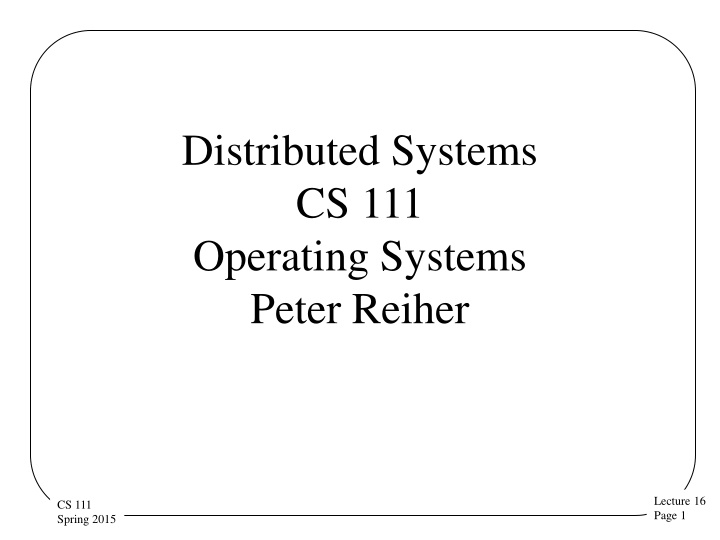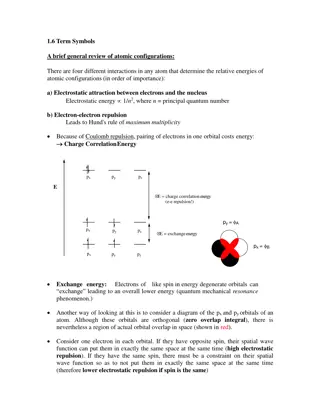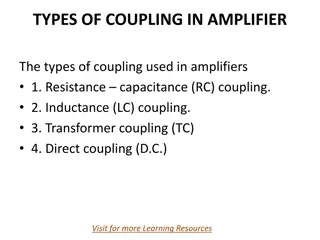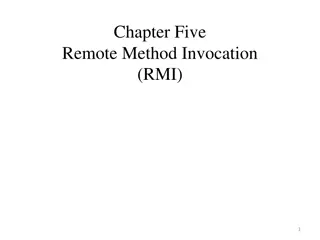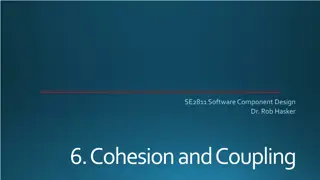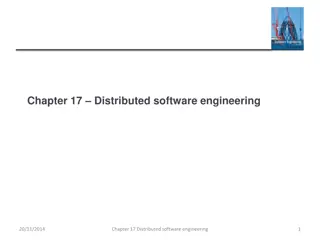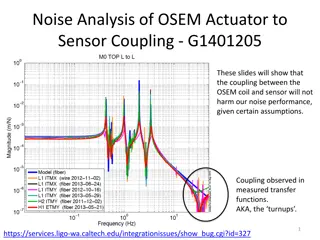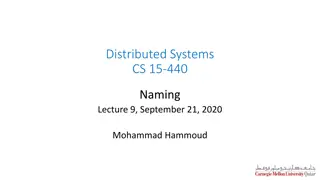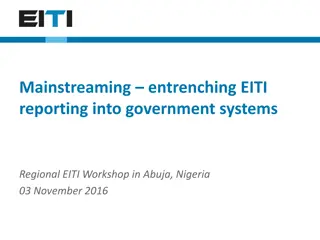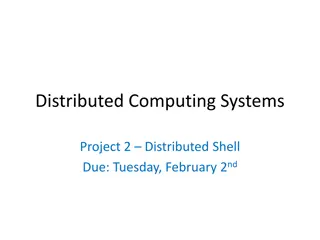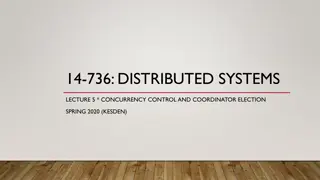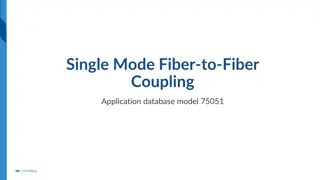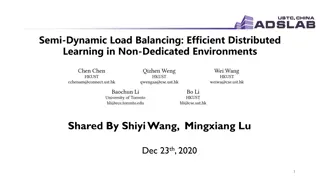Distributed Systems Overview: Goals, Characteristics, Transparency, and Coupling
This content delves into the goals and vision of distributed computing, important characteristics of distributed systems, types of transparency, and the concepts of loosely and tightly coupled systems in the realm of distributed computing. It covers topics such as scalability, availability, performance overhead, transparency types, and the degree of system coupling. Gain insights into how distributed systems operate and the key aspects that define their functionality.
Download Presentation

Please find below an Image/Link to download the presentation.
The content on the website is provided AS IS for your information and personal use only. It may not be sold, licensed, or shared on other websites without obtaining consent from the author.If you encounter any issues during the download, it is possible that the publisher has removed the file from their server.
You are allowed to download the files provided on this website for personal or commercial use, subject to the condition that they are used lawfully. All files are the property of their respective owners.
The content on the website is provided AS IS for your information and personal use only. It may not be sold, licensed, or shared on other websites without obtaining consent from the author.
E N D
Presentation Transcript
Distributed Systems CS 111 Operating Systems Peter Reiher Lecture 16 Page 1 CS 111 Spring 2015
Outline Goals and vision of distributed computing Basic architectures Symmetric multiprocessors Single system image distributed systems Cloud computing systems User-level distributed computing Distributed file systems Lecture 16 Page 2 CS 111 Spring 2015
Goals of Distributed Computing Better services Scalability Some applications require more resources than one computer has Should be able to grow system capacity to meet growing demand Availability Disks, computers, and software fail, but services should be 24x7! Improved ease of use, with reduced operating expenses Ensuring correct configuration of all services on all systems New services Applications that span multiple system boundaries Global resource domains, services decoupled from systems Complete location transparency Lecture 16 Page 3 CS 111 Spring 2015
Important Characteristics of Distributed Systems Performance Overhead, scalability, availability Functionality Adequacy and abstraction for target applications Transparency Compatibility with previous platforms Scope and degree of location independence Degree of coupling How many things do distinct systems agree on? How is that agreement achieved? Lecture 16 Page 4 CS 111 Spring 2015
Types of Transparency Network transparency Is the user aware he s going across a network? Name transparency Does remote use require a different name/kind of name for a file than a local user? Location transparency Does the name change if the file location changes? Performance transparency Is remote access as quick as local access? Lecture 16 Page 5 CS 111 Spring 2015
Loosely and Tightly Coupled Systems Tightly coupled systems Share a global pool of resources Agree on their state, coordinate their actions Loosely coupled systems Have independent resources Only coordinate actions in special circumstances Degree of coupling Tight coupling: global coherent view, seamless fail-over But very difficult to do right Loose coupling: simple and highly scalable But a less pleasant system model Lecture 16 Page 6 CS 111 Spring 2015
Globally Coherent Views Everyone sees the same thing Usually the case on single machines Harder to achieve in distributed systems How to achieve it? Have only one copy of things that need single view Limits the benefits of the distributed system And exaggerates some of their costs Ensure multiple copies are consistent Requiring complex and expensive consensus protocols Not much of a choice Lecture 16 Page 7 CS 111 Spring 2015
Major Classes of Distributed Systems Symmetric Multi-Processors (SMP) Multiple CPUs, sharing memory and I/O devices Single-System Image (SSI) & Cluster Computing A group of computers, acting like a single computer Loosely coupled, horizontally scalable systems Coordinated, but relatively independent systems Cloud computing is the most widely used version Application level distributed computing Application level protocols Distributed middle-ware platforms Lecture 16 Page 8 CS 111 Spring 2015
Symmetric Multiprocessors (SMP) What are they and what are their goals? OS design for SMP systems SMP parallelism The memory bandwidth problem Lecture 16 Page 9 CS 111 Spring 2015
SMP Systems Computers composed of multiple identical compute engines Each computer in SMP system usually called a node Sharing memories and devices Could run same or different code on all nodes Each node runs at its own pace Though resource contention can cause nodes to block Examples: BBN Butterfly parallel processor More recently, multi-way Intel servers Lecture 16 Page 10 CS 111 Spring 2015
SMP Goals Price performance Lower price per MIP than single machine Since much of machine is shared Scalability Economical way to build huge systems Possibility of increasing machine s power just by adding more nodes Perfect application transparency Runs the same on 16 nodes as on one Except faster Lecture 16 Page 11 CS 111 Spring 2015
A Typical SMP Architecture CPU 1 CPU 2 CPU 3 CPU 4 interrupt controller cache cache cache cache shared memory & device busses device controller device controller device controller memory Lecture 16 Page 12 CS 111 Spring 2015
SMP Operating Systems One processor boots with power on It controls the starting of all other processors Same OS code runs in all processors One physical copy in memory, shared by all CPUs Each CPU has its own registers, cache, MMU They cooperatively share memory and devices ALL kernel operations must be Multi-Thread- Safe Protected by appropriate locks/semaphores Very fine grained locking to avoid contention Lecture 16 Page 13 CS 111 Spring 2015
Handling Kernel Synchronization Multiple processors are sharing one OS copy What needs to be synchronized? Every potentially sharable OS data structure Process descriptors, file descriptors, data buffers, message queues, etc. All of the devices Could we just lock the entire kernel, instead? Yes, but it would be a bottleneck Remember lock contention? Avoidable by not using coarse-grained locking Lecture 16 Page 14 CS 111 Spring 2015
SMP Parallelism Scheduling and load sharing Each CPU can be running a different process Just take the next ready process off the run-queue Processes run in parallel Most processes don't interact (other than inside kernel) If they do, poor performance caused by excessive synchronization Serialization Mutual exclusion achieved by locks in shared memory Locks can be maintained with atomic instructions Spin locks acceptable for VERY short critical sections If a process blocks, that CPU finds next ready process Lecture 16 Page 15 CS 111 Spring 2015
The Challenge of SMP Performance Scalability depends on memory contention Memory bandwidth is limited, can't handle all CPUs Most references better be satisfied from per-CPU cache If too many requests go to memory, CPUs slow down Scalability depends on lock contention Waiting for spin-locks wastes time Context switches waiting for kernel locks waste time This contention wastes cycles, reduces throughput 2 CPUs might deliver only 1.9x performance 3 CPUs might deliver only 2.7x performance Lecture 16 Page 16 CS 111 Spring 2015
Managing Memory Contention Each processor has its own cache Cache reads don t cause memory contention Writes are more problematic Locality of reference often solves the problems Different processes write to different places Keeping everything coherent still requires a smart memory controller Fast n-way memory controllers are very expensive Without them, memory contention taxes performance Cost/complexity limits how many CPUs we can add Lecture 16 Page 17 CS 111 Spring 2015
Single System Image Approaches Built a distributed system out of many more- or-less traditional computers Each with typical independent resources Each running its own copy of the same OS Usually a fixed, known pool of machines Connect them with a good local area network Use software techniques to allow them to work cooperatively Often while still offering many benefits of independent machines to the local users Lecture 16 Page 22 CS 111 Spring 2015
Motivations for Single System Image Computing High availability, service survives node/link failures Scalable capacity (overcome SMP contention problems) You re connecting with a LAN, not a special hardware switch LANs can host hundreds of nodes Good application transparency Examples: Locus, Sun Clusters, MicroSoft Wolf-Pack, OpenSSI Enterprise database servers Lecture 16 Page 23 CS 111 Spring 2015
Why Did This Sound Like a Good Idea? Programs don t run on hardware, they run on top of an operating system All the resources that processes see are already virtualized Don t just virtualize a single system s resources, virtualize many systems resources Applications that run in such a cluster are (automatically and transparently) distributed Lecture 16 Page 24 CS 111 Spring 2015
The SSI Vision physical systems proc 101 proc 103 proc 106 CD1 lock 1A one global pool of devices Virtualcomputer with 4x MIPS & memory processes 101, 103, 106, + 202, 204, 205, + 301, 305, 306, + 403, 405, 407 CD1 LP2 proc 202 proc 204 proc 205 CD3 locks 1A, 3B CD3 one largevirtualfile system proc 301 proc 305 proc 306 LP2 primary copies LP3 lock 3B LP3 disk 1A disk 2A disk 3A disk 4A SCN4 disk 3B disk 4B disk 1B disk 2B SCN4 proc 403 proc 405 proc 407 secondary replicas Lecture 16 Page 25 CS 111 Spring 2015
OS Design for SSI Clusters All nodes agree on the state of all OS resources File systems, processes, devices, locks, IPC ports Any process can operate on any object, transparently They achieve this by exchanging messages Advising one another of all changes to resources Each OS s internal state mirrors the global state To execute node-specific requests Node-specific requests automatically forwarded to right node The implementation is large, complex, and difficult The exchange of messages can be very expensive Lecture 16 Page 26 CS 111 Spring 2015
SSI Performance Clever implementation can reduce overhead But 10-20% overhead is common, can be much worse Complete transparency Even very complex applications just work They do not have to be made network aware Good robustness When one node fails, others notice and take-over Often, applications won't even notice the failure Each node hardware-independent Failures of one node don t affect others, unlike some SMP failures Very nice for application developers and customers But they are complex, and not particularly scalable Lecture 16 Page 27 CS 111 Spring 2015
An Example of SSI Complexity Keeping track of which nodes are up Done in the Locus Operating System through topology change Need to ensure that all nodes know of the identity of all nodes that are up By running a process to figure it out Complications: Who runs the process? What if he s down himself? Who do they tell the results to? What happens if things change while you re running it? What if the system is partitioned? Lecture 16 Page 28 CS 111 Spring 2015
Is It Really That Bad? Nodes fail and recovery rarely So something like topology change doesn t run that often But consider a more common situation Two processes have the same file open What if they re on different machines? What if they are parent and child, and share a file pointer? Basic read operations require distributed agreement Or, alternately, we compromise the single image Which was the whole point of the architecture Lecture 16 Page 29 CS 111 Spring 2015
Scaling and SSI Scaling limits proved not to be hardware driven Unlike SMP machines Instead, driven by algorithm complexity Consensus algorithms, for example Design philosophy essentially requires distributed cooperation So this factor limits scalability Lecture 16 Page 30 CS 111 Spring 2015
Lessons Learned From SSI Consensus protocols are expensive They converge slowly and scale poorly Systems have a great many resources Resource change notifications are expensive Location transparency encouraged non-locality Remote resource use is much more expensive A very complicated operating system design Distributed objects are much more complex to manage Complex optimizations to reduce the added overheads New modes of failure with complex recovery procedures Lecture 16 Page 31 CS 111 Spring 2015
Loosely Coupled Systems Characterization: A parallel group of independent computers Serving similar but independent requests Minimal coordination and cooperation required Motivation: Scalability and price performance Availability if protocol permits stateless servers Ease of management, reconfigurable capacity Examples: Web servers, app servers, cloud computing Lecture 16 Page 32 CS 111 Spring 2015
Horizontal Scalability Each node largely independent So you can add capacity just by adding a node on the side Scalability can be limited by network, instead of hardware or algorithms Or, perhaps, by a load balancer Reliability is high Failure of one of N nodes just reduces capacity Lecture 16 Page 33 CS 111 Spring 2015
Horizontal Scalability Architecture If I need more web server capacity, WAN to clients load balancing switch with fail-over web server web server web server web server web server app server app server app server app server app server content distribution server HA database server Lecture 16 Page 34 CS 111 Spring 2015
Elements of Loosely Coupled Architecture Farm of independent servers Servers run same software, serve different requests May share a common back-end database Front-end switch Distributes incoming requests among available servers Can do both load balancing and fail-over Service protocol Stateless servers and idempotent operations Successive requests may be sent to different servers Lecture 16 Page 35 CS 111 Spring 2015
Horizontally Scaled Performance Individual servers are very inexpensive Blade servers may be only $100-$200 each Scalability is excellent 100 servers deliver approximately 100x performance Service availability is excellent Front-end automatically bypasses failed servers Stateless servers and client retries fail-over easily The challenge is managing thousands of servers Automated installation, global configuration services Self monitoring, self-healing systems Scaling limited by management, not HW or algorithms Lecture 16 Page 36 CS 111 Spring 2015
What About the Centralized Resources? The load balancer appears to be centralized And what about the back-end databases? Are these single points of failure for this architecture? And also limits on performance? Yes, but . . . Lecture 16 Page 37 CS 111 Spring 2015
Handling the Limiting Factors The centralized pieces can be special hardware There are very few of them So they can use aggressive hardware redundancy Expensive, but only for a limited set of machines They can also be high performance machines Some of them have very simple functionality Like the load balancer With proper design, their roles can be minimized, decreasing performance problems Lecture 16 Page 38 CS 111 Spring 2015
Cloud Computing The most recent twist on distributed computing Set up a large number of machines all identically configured Connect them to a high speed LAN And to the Internet Accept arbitrary jobs from remote users Run each job on one or more nodes Entire facility probably running mix of single machine and distributed jobs, simultaneously Lecture 16 Page 43 CS 111 Spring 2015
Distributed Computing and Cloud Computing In one sense, these are orthogonal Each job submitted might or might not be distributed Many of the hard problems of the distributed jobs are the user s problem, not the system s E.g., proper synchronization and locking But the cloud facility must make communications easy Lecture 16 Page 44 CS 111 Spring 2015
What Runs in a Cloud? In principle, anything But general distributed computing is hard So much of the work is run using special tools These tools support particular kinds of parallel/distributed processing Either embarrassingly parallel jobs Or those using a method like map-reduce Things where the user need not be a distributed systems expert Lecture 16 Page 45 CS 111 Spring 2015
Embarrassingly Parallel Jobs Problems where it s really, really easy to parallelize them Probably because the data sets are easily divisible And exactly the same things are done on each piece So you just parcel them out among the nodes and let each go independently Everyone finishes at more or less same time Lecture 16 Page 46 CS 111 Spring 2015
The Most Embarrassing of Embarrassingly Parallel Jobs Say you have a large computation You need to perform it N times, with slightly different inputs each time Each iteration is expected to take the same time If you have N cloud machines, write a script to send one of the N jobs to each You get something like N times speedup Lecture 16 Page 47 CS 111 Spring 2015
MapReduce Perhaps the most common cloud computing software tool/technique A method of dividing large problems into compartmentalized pieces Each of which can be performed on a separate node With an eventual combined set of results Lecture 16 Page 48 CS 111 Spring 2015
The Idea Behind MapReduce There is a single function you want to perform on a lot of data Such as searching it for a string Divide the data into disjoint pieces Perform the function on each piece on a separate node (map) Combine the results to obtain output (reduce) Lecture 16 Page 49 CS 111 Spring 2015
An Example We have 64 megabytes of text data Count how many times each word occurs in the text Divide it into 4 chunks of 16 Mbytes Assign each chunk to one processor Perform the map function of count words on each Lecture 16 Page 50 CS 111 Spring 2015
The Example Continued 1 2 3 4 Foo 1 Bar 4 Baz 3 Zoo 6 Yes 12 Too 5 Foo 7 Bar 3 Baz 9 Zoo 1 Yes 17 Too 8 Foo 2 Bar 6 Baz 2 Zoo 2 Yes 10 Too 4 Foo 4 Bar 7 Baz 5 Zoo 9 Yes 3 Too 7 That s the map stage Lecture 16 Page 51 CS 111 Spring 2015
On To Reduce We might have two more nodes assigned to doing the reduce operation They will each receive a share of data from a map node The reduce node performs a reduce operation to combine the shares Outputting its own result Lecture 16 Page 52 CS 111 Spring 2015
Continuing the Example Foo 1 Bar 4 Baz 3 Zoo 6 Yes 12 Too 5 Foo 7 Bar 3 Baz 9 Zoo 1 Yes 17 Too 8 Foo 2 Bar 6 Baz 2 Zoo 2 Yes 10 Too 4 Foo 4 Bar 7 Baz 5 Zoo 9 Yes 3 Too 7 Lecture 16 Page 53 CS 111 Spring 2015
The Reduce Nodes Do Their Job Write out the results to files And MapReduce is done! Foo 14 Bar 20 Baz 19 Zoo 16 Yes 42 Too 24 Lecture 16 Page 54 CS 111 Spring 2015
But I Wanted A Combined List No problem Run another (slightly different) MapReduce on the outputs Have one reduce node that combines everything Lecture 16 Page 55 CS 111 Spring 2015
Synchronization in MapReduce Each map node produces an output file for each reduce node It is produced atomically The reduce node can t work on this data until the whole file is written Forcing a synchronization point between the map and reduce phases Lecture 16 Page 56 CS 111 Spring 2015
Do-It-Yourself Distributed Computing in the Cloud Generally, you can submit any job you want to the cloud If you want to run a SSI or horizontally scaled loosely coupled system, be their guest Assuming you pay, of course They ll offer basic system tools You ll do the distributed system heavy lifting Wouldn t it be nice if you had some middleware to help . . . ? Lecture 16 Page 57 CS 111 Spring 2015
Another Distributed System Side To Cloud Computing From the perspective of the provider He has N nodes and M client tasks He farms out nodes to the clients as his business model suggests He needs to set up efficient communications between each client s share of nodes He needs to protect clients from each other Leading to a different class of distributed systems problems Lecture 16 Page 58 CS 111 Spring 2015
